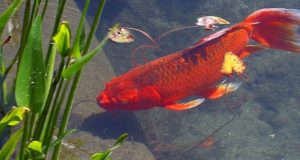 The thought of a freshwater counterpart to the stealthy marine barracuda is just awesome to me. There are several fish called freshwater barracuda, but in the world of cichlids, Rhamphochromis fits the bill. So, I tend to get excited when I hear anything about Rhamphochromis, especially when they arrive in the store. I’ve never kept these fish, but I can see them in my future. Here are some things you may want to know if you’re as intrigued as I am.
The thought of a freshwater counterpart to the stealthy marine barracuda is just awesome to me. There are several fish called freshwater barracuda, but in the world of cichlids, Rhamphochromis fits the bill. So, I tend to get excited when I hear anything about Rhamphochromis, especially when they arrive in the store. I’ve never kept these fish, but I can see them in my future. Here are some things you may want to know if you’re as intrigued as I am.
Rhamphochromis are elongate, silvery, torpedo-shaped fish, designed to swim swiftly in pursuit of prey. They are found in the deep waters of Lake Malawi. Some species venture close to shore to prey on young cichlids, where they are sometimes caught. It’s possible that the four that recently arrived to us made the same mistake, much to my delight. These are Rhampochromis macrophthalmus, which are silver with two horizontal lines on the body and bright yellow pelvic and anal fins. Of the four we received, three have the yellow fins and the fourth has clear fins, a female perhaps.
The four wild specimens we got in are very interesting. Though they’re natural born predators in the lakes, chasing down and swallowing other fish, these individuals ate pellets from day one. Feeding these guys has been really easy…they are always hungry and seem to take anything offered.
If it wasn’t for the fact that I’m trying to breed Cuban cichlids right now, a pair of these would already be calling my apartment home. I don’t really know anyone who has bred these guys. From the info I’ve been able to gather, it seems that courtship begins when the fish hit about five inches. Around this time, male aggression becomes heightened as well, so you have to keep an eye on tank mates. Rhamps seem to be mouthbrooders. An interesting spawning note – it takes place at the surface of the water. As the eggs fall the female will catch them in mid-water, almost like bettas. I have my eyes on this female to see if she starts carrying, but there’s no sign of spawning yet. Let’s cross our fingers!
The demand for these fish amongst hobbyists is not great compared to some of their other colorful cousins. In all my time keeping cichlids, I have only come across them maybe 6 times for sale or trade. They’re usually sought after or purchased by the person looking for something different to occupy their large species African cichlid tank. Because these fish are active swimmers, a 6 foot or larger aquarium would be the best for them. Hopefully, someone looking to add a very interesting fish to their cichlid tank or hoping to observe a different spawning method will give these fish a new home. I don’t think any cichlid enthusiast will be disappointed.
I’d love to hear from anyone keeping these fish or think about keeping them, leave me a comment!
Until next time,
Jose
 That Fish Blog – Aquarium Advice and Information
That Fish Blog – Aquarium Advice and Information


If you ever are successful in getting any fry from these guys, I would be interested in a few. Or if you want to sell them, I would like to give it a try at breeding them.
Hi Jose, I would be interested in the Barracudas. I’ve had them before. Just this past Monday we moved. During this move the Barracuda didn’t survive! Please let Me know?
Thanks,
Michael
Hi Michael, You’ll actually want to contact livefish@thatpetplace.com for availability…if they aren’t in stock, we can try to get them for you.
Yes, could You please try and get some of them for Me??
Michael
You’ll have to contact livefish@thatpetplace.com or the livestock department at 1-877-367-4377 to request these fish. They can contact you when they’re able to get them for you.
I obtained a wild caught trio of rhamphochromis macrophthalmus back in the early 1990s. Originally the trio came from AquaScience research center in Kansas City Mo. I first spawned these in a 115 gallon aquarium by them selves. And then was successful in a 75 gal. They were about 7 inches at the time.
Spawning took place in an open area in front of the tank. Like many other Africans I would wait till the storms move in in early spring and do a 75% water change. Wait about 3 hours and they would start their dancing courtship. They are mouth brooders.
Eggs were beige colored and about 1/8th of an inch and about 18 to 20. Fry are large enough to feed small granular foods.
This past week I obtained another trio of the rhamphochromis ferox I was told. But look like macrophthalmus. Looking for species identification if there are any to the naked eye